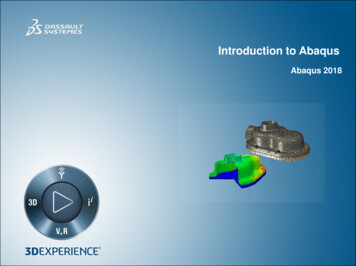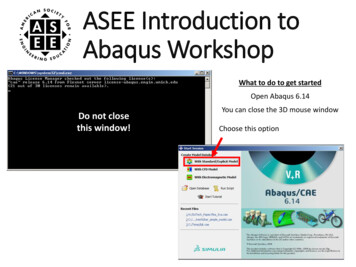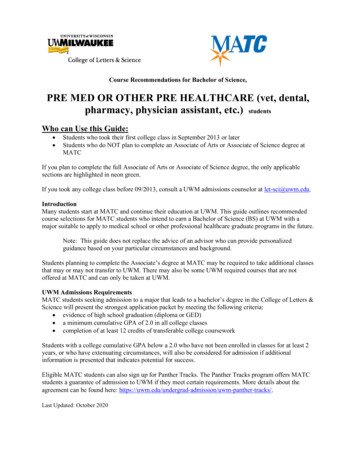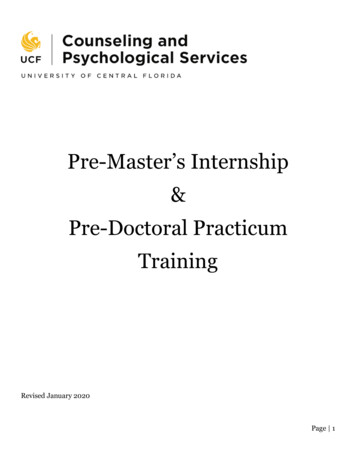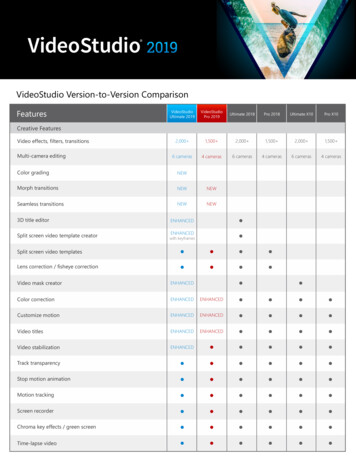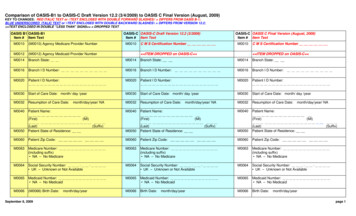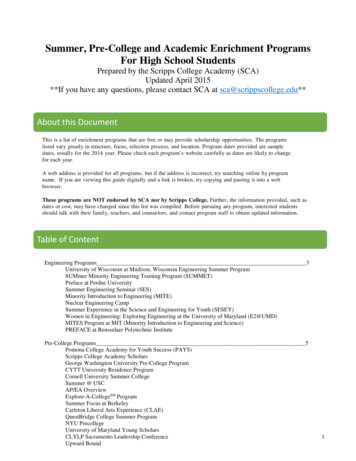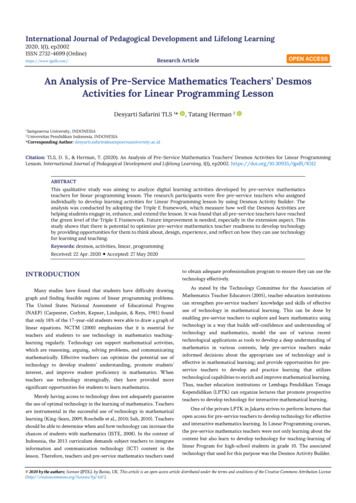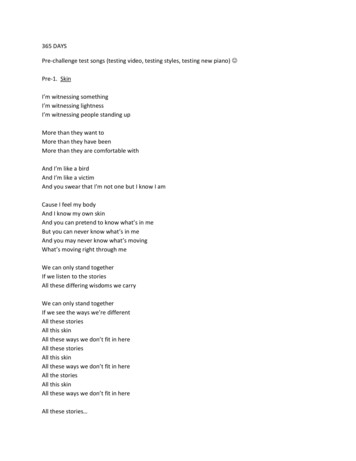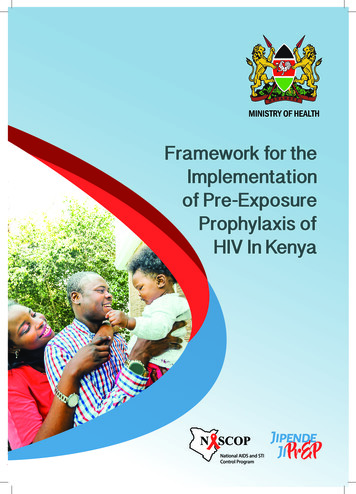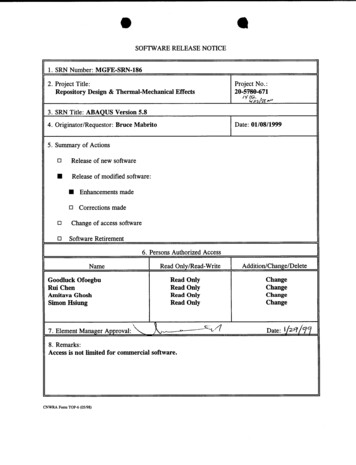
Transcription
SOFTWARE RELEASE NOTICE[ 1.SRN Number: MGFE-SRN-1862. Project Title:Repository Design & Thermal-Mechanical EffectsProject No.:20-5780-6713. SRN Title: ABAQUS Version 5.84. Originator/Requestor: Bruce MabritoDate: 01/08/19995. Summary of ActionsclRelease of new software*Release of modified software:aO1*Enhancements made0Corrections madeChange of access softwareSoftware Retirement6. Persons Authorized AccessNameGoodluck OfoegbuRui ChenAxnitava GhoshSimon Hsiung7. Element Manager Approval: Read Only/Read-WriteRead OnlyRead OnlyRead OnlyRead Only,k.t8. Remarks:Access is not limited for commercial software.CNWRA Form TOP-6 (05/98) :
SOFTWARE SUMMARY FORM01. Summary Date:01/08/9902. Summary prepared by (Name and phone)Bruce Mabrito, (210) 522-514904. Software Date:01/08/9905. Short Title:ABAQUS Version 5.803. Summary Action:New 06. Software Title: ABAQUS 5'8lG/-190-007. Internal SoftwareID: NONE08. Software Type:09. Processing Mode:o Automated Data System* Interactive* Computer Program* Batch10. APPLICATION AREAa. General:* Scientific/Engineering0 Auxiliary Analyses0 Total System PA0 Subsystem PA0 Othero Subroutine/Module0 Combinationb. Specific:11. Submitting Organization and Address:12. Technical Contact(s) and Phone:CNWRA/SwRI6220 Culebra RoadSan Antonio, TX 78228Goodluck Ofoegbu (210) 522-664113. Software Application: Used for Thermal and Mechanical modeling.14. Computer Platform"Pluto" Server(Silicon Graphics)15. Computer OperatingSystem: IRIS 6.518. Computer MemoryRequirements:19. Tape Drives:16. Programming Language(s):17. Number of SourceProgram Statements:FORTRANN/A20. Disk/Drum Units:NONE21. Graphics:N/AXWINDOW System22. Other Operational RequirementsNONE23. Software Availability:lo Available24. Documentation Availability:* Limited0In-House ONLY* AvailableSoftware Developer:CNWRA FornnTOPAZ0 Inadequate2Date:Tfa& lo"U(E-.'(USat1 "A K -10 In-House ONLYII
Pluto root: /apps/abaqus/tm*2) /apps/abaqus/bin/verifyRunning ABAQUS/Standard verification.stdinst.inp .stdinst has passed verification.****** ************Verification of ABAQUS completed successfully.1ilQ -l5-50
SSOFTWARE VALIDATION TEST PLAN FORABAQUS VERSIONS 5.8-16 AND 6.2January 2002Center for Nuclear Waste Regulatory AnalysesSouthwest Research InstituteSan Antonio, TexasAuthorDoGuteDateElement Manager2 - 114 - 0')-Asadul ChowdhuryDate
1.0Scope of the ValidationABAQUS Versions 5.8-16 and 6.2 are acquired software not to be modified and underconfiguration control at the Center for Nuclear Waste Regulatory Analyses (CNWRA), softwarerelease numbers MGFE-SRN-250 and MGFE-SRN-247, respectfully. ABAQUS is a finiteelement (FE) analysis program developed by Hibbitt, Karlsson & Sorensen (HKS), Inc. TheHKS, Inc. main office is located at 1080 Main Street, Pawtucket, Rhode Island, 02860-4847.The ABAQUS program can be purchased with several different analysis options and utilities.Of the many available options, the CNWRA is only licensed to use the implicit(ABAQUS/Standard) and explicit (ABAQUS/Explicit) solution algorithms and the model pre- andpost-processing program module (ABAQUS/CAE).A general overview of the capabilities, utilities, and functionality provided by the ABAQUSsoftware codes used by the CNWRA can be found in Appendix A. A more extensivepresentation of this information can be found on the CD-ROM included with this SVTP (seeTable 1.1)Table 1.1 Files Conveying the Capabilities, Utilities, and Functionality of the ABAQUSSoftware Codes Used by the Center for Nuclear Waste Regulatory AnalysesABAQUS Software CodeFile NameABAQUS/Standard6-2standard .pdfHKS, Inc. maintains a rigorous Quality Assurance (QA) program. Appendix B presents the fulltext of the HKS, Inc. description of their QA standards and corresponding certifications. Thisdocumentation was obtained from the HKS, Inc. web site (www.hks.com). In summary, HKS,Inc. QA procedures meet the ISO 9001 and American National Standards Institute(ANSI)/American Society of Mechanical Engineers (ASME) NQA-1 QA standards. TheANSI/ASME NQA-1 standard is designed to ensure compliance with Appendix B of U.S. Codeof Federal Regulations 10 CFR 50 (1-1-86 Edition) and, as a result, conforms to the U.S.Nuclear Regulatory Commission's QA requirements. Verification, Benchmarking, and ExampleProblems Manuals (HKS, Inc.; 1998a, b, c, d; 2001 a, b, c) and Error Status Reports are integralcomponents of the HKS, Inc. QA program. In addition, ABAQUS also performs installationtests automatically when the software is installed on a client's computer platform. TheABAQUS program notifies the installer of the program, by way of messages written to thescreen and a log file, the nature of any errors indicating that the installation of the program wasnot done correctly.Before releasing updates of the various ABAQUS software codes for commercial use, HKSensures that the code must be capable of solving an extensive number of verification,benchmarking, and example problem test cases satisfactorily. The results of these test casesare documented in the aforementioned Verification, Benchmarking, and Example ProblemManuals. Table 1.2 delineates the names of the files for the various ABAQUS Manuals thathave been stored on the CD-ROM included with this SVTP. The ABAQUS Verification Manual1
contains a large number of test cases that serve as basic verification of the various ABAQUSprograms. Each test case verifies one or several well-defined options in the code. The testcases are sufficiently small that, in most cases, the correct results can be calculated by hand.This manual is divided into chapters based on the type of capability that is tested. Theproblems in the element verification chapter test the element library extensively. Otherchapters document tests of materials, procedures, user subroutines, miscellaneous options,and importing results from ABAQUS/Explicit into ABAQUS/Standard. In addition to theVerification Manual, there are two other manuals that contain worked problems. The ABAQUSBenchmarks Manual contains benchmark problems (including the NAFEMS suite of testproblems) and standard analyses used to evaluate the performance of ABAQUS. The tests inthis manual are multiple element tests of simple geometries or simplified versions of realproblems. The ABAQUS Example Problems Manual contains many solved examples that testthe code with the type of problems that users are likely to solve. Many of these problems arequite complex and test a combination of capabilities in the code.Table 1.2 ABAQUS Manuals Relevant to Software Validation and the File Names for theAvailable Electronic VersionsApplicable SoftwareManualABAQUS/Standard'Verification Manual, 5.8*ABAQUS/StandardABAQUS/StandardExample Problems Manual, 5.8*ABAQUS/StandardABAQUS/ExplicittExample Problems Manual, 5.8*File NameExamples Manual Explicit*ABAQUS/CAEABAQUSVerification Manual, 6.2VerificationManual 6-2.pdfABAQUS.encn Manual, 6.2Benchmarking Manual, arking-Manual 6-2.pdfABAQUSExample Problems Manual, es-Manual 6-2.pdft**Hard copy only.The most recent versions of the Error Status Reports, which are constantly updated andmaintained by HKS, Inc., are accessible at any time via their public ftp site (i.e.,ftp.abaqus.com). The complete Error Status Reports for the program modules of interest to theCNWRA at the time this SVTP was developed are stored on the attached CD-ROM. Theapplicability and file names of these Error Status Reports can be found in Table 1-3. TheseError Status Reports document the assigned error number, nature of the error, the status of theerror resolution process, and the affected program modules.2
Table 1.3 Files Names for the ABAQUS Error Status ReportsABAQUS Application/UtilityFile NameABAQUS/Standard, Version 5.8stde58.pdfABAQUS/Standard, Version 6.2stde62.pdfABAQUS/Explicit, Version 5.8xple58.pdfABAQUS/Explicit, Version 6.2xple62.pdfABAQUS/CAE, Version 5.8, and relatedprogram and system utilitiescaee58.pdf, intfe58.pdf, designe58.pdf,pste58.pdf, utle58.pdfABAQUS/CAE, Version 6.2, and relatedprogram and system utilitiescaee62.pdf, intfe62.pdf, designe62.pdf,pste62.pdf, utle62.pdfAccording to Table 1 of Technical Operating Procedure TOP-01 8, Development and Control ofScientific and Engineering Software, acquired software not to be modified must undergoAcceptance and Validation Testing and satisfy Configuration Control, QA Verification, and QARelease documentation requirements. Furthermore, as noted in Table 1 of TOP-01 8,Acceptance Testing for acquired software not to be modified is limited to Installation Testingonly. Software Validation Testing, per Subsection 5.10.1 of TOP-018, for acquired software notto be modified ". shall consist of one or more of the following (i) tests that provide evidence ofcorrect and successful implementation of the underlying theory and algorithms, as outlined inthe CNWRA initiated Software Requirements Description (SRD)/Software Change Report(SCR) or the development organization's literature, for acquired software, (ii) comparison toresearch papers, laboratory experiments, existing test cases or previously published sources ofdata, and (iii) benchmarking or comparative testing against results from other software. Thesoftware validation may be limited to a range of the capability of the software, commensuratewith its anticipated use in regulatory reviews. For software with separately operable modulesthe Software Validation Testing Plan (SVTP) will describe which modules are to be validatedand with what couplings (if any) between modules."Because of the extensive tests and error documentation made available by the vendor (i.e.,HKS, Inc.), the scope of the ABAQUS software validation will be limited to verifying that asample of test problems presented in the ABAQUS Verification, Benchmarking, and ExampleProblems Manuals are solved satisfactorily on the computer platforms used by the CNWRA.This approach to validating the ABAQUS software programs provides ".evidence of correctand successful implementation of the underlying theory and algorithms, as outlined in the .development organization's literature, for acquired software" as required by TOP-018. Thespecific test problems to be used for this purpose are identified in Section 6, Test Cases. Thesetest problems have been chosen such that they represent an acceptable percentage(i.e., 10 %) ".of the capability of the software, commensurate with its anticipated use inregulatory reviews."3
2.0ReferencesHibbitt, Karlsson & Sorensen, Inc. ABAQUS/Standard Verification Manual, Version 5.8.Pawtucket, Rhode Island: Hibbitt, Karlsson & Sorensen, Inc. 1998a.Hibbitt, Karlsson & Sorensen, Inc. ABAQUS/Standard Example Problems Manual, Volume I,Version 5.8. Pawtucket, Rhode Island: Hibbitt, Karlsson & Sorensen, Inc. 1998b.Hibbitt, Karlsson & Sorensen, Inc. ABAQUS/Standard Example Problems Manual, Volume II,Version 5.8. Pawtucket, Rhode Island: Hibbitt, Karlsson & Sorensen, Inc. 1998c.Hibbitt, Karlsson & Sorensen, Inc. ABAQUS/Explicit Example Problems Manual, Version 5.8.Pawtucket, Rhode Island: Hibbitt, Karlsson & Sorensen, Inc. 1998d.Hibbitt, Karlsson & Sorensen, Inc. ABAQUS Verification Manual, Version 6.2. Pawtucket,Rhode Island: Hibbitt, Karlsson & Sorensen, Inc. 2001a.Hibbitt, Karlsson & Sorensen, Inc. ABAQUS Benchmarking Manual, Version 6.2. Pawtucket,Rhode Island: Hibbitt, Karlsson & Sorensen, Inc. 2001b.Hibbitt, Karlsson & Sorensen, Inc. ABAQUS Example Problems Manual, Version 6.2.Pawtucket, Rhode Island: Hibbitt, Karlsson & Sorensen, Inc. rd, Version 5.8-16, UNIX compatible operating systemABAQUS/Standard, Version 6.2, UNIX compatible operating systemABAQUS/Explicit, Version 5.8-16, UNIX compatible operating systemABAQUS/Explicit, Version 6.2, UNIX compatible operating systemABAQUS/CAE, Version 5.8-16, UNIX compatible operating systemABAQUS/CAE, Version 6.2, UNIX compatible operating system3.2Hardware**Sun 1420R Server (Solaris 8 operating system)Silicon Graphics Inc. (SGI) ONYX 2 (IRIX 6.5 Release 12 operating system)4.0PrerequisitesNo prerequisites required to implement the SVTP.5.0Assumptions and ConstraintsNo assumptions and constraints required to implement the SVTP.4
6.0Test CasesThe test cases identified in Table 6-1 were taken from the ABAQUS Benchmarks Manual,Version 6.2 (see the BenchmarksManual-6-2.pdf file stored on the CD-ROM). These testcases will be used to validate ABAQUS/Standard, Versions 5.8-16 and 6.2, andABAQUS/Explicit, Versions 5.8-16 and 6.2. ABAQUS/CAE will be validated by demonstratingthat the hardcopy version of the calculated results obtained from the test cases are accuratelydisplayed via the Graphical Users Interface (GUI). Documentation provided in the ABAQUSBenchmarks Manual, Version 6.2, addresses the input, procedure, and results relevant to eachtest case. Specifically, the test cases demonstrate the codes ability to model concrete, missileimpact and penetration, damped vibrations, and brittle material (e.g., concrete) failure. Aspointed out in Chapter 1, these test problems have been chosen such that they represent anacceptable percentage (i.e., 10 %) ".of the capability of the software, commensurate with itsanticipated use in regulatory reviews."Table 6-1. ABAQUS Validation Test ProblemsTest Case Number7.0Test Case TitleApplicable ABAQUS Module1.1.10Concrete Slump TestABAQUS/StandardVersions 5.8-16 and 6.21.3.16Plate Penetration by a ProjectileABAQUS/Explicit1.4.41.4.4Free and Forced Vibrations withDampingABAQUS/StandardVersions 5.8-16 and 6.23.2.123.2.12Mixed-mode Failure of a NotchedUnreinforced Concrete BeamABAQUS/ExplicitVersions 5.8-16 and 6.2NotesNone.5
0APPENDIX AABAQUS Product Descriptions6
A.1ABAQUS/StandardAs described in the available HKS, Inc. web site ml), ABAQUS/Standard is a general purpose,production-oriented finite element program designed specifically for advance analysisapplications. ABAQUS/Standard provides a variety of time- and frequency-domain analysisprocedures. These procedures are divided into two classes: "general analyses," in which theresponse may be linear or nonlinear, and "linear perturbation analyses," in which linearresponse is computed about a general, possibly nonlinear, base state. A single simulation caninclude multiple analysis types. The following enumerates the various analysis and modelingcapabilities of ABAQUS/Standard.General Analyses******Static stress/displacement analysisViscoelastic/viscoplastic responseTransient dynamic stress/displacement analysisTransient or steady-state heat transfer analysisTransient or steady-state mass diffusion analysisSteady-state transport analysis*Coupled problems:-Thermo-mechanical (sequentially or fully coupled)Thermo-electricalPore fluid flow-mechanicalStress-mass diffusion (sequentially coupled)Piezoelectric (linear only)Acoustic-mechanical (linear only)Linear Perturbation Analyses*Static stress/displacement analysis:-*Linear static stress/displacement analysisEigenvalue buckling load predictionDynamic stress/displacement analysis:-Determination of natural modes and frequenciesTransient response via modal superpositionSteady-state response resulting from harmonic loadingResponse spectrum analysisDynamic response resulting from random loading7
MaterialsModels are provided for metals, cast iron, rubber, plastics, composites, resilient and crushablefoam, concrete, sand, clay, and jointed rock. The material response for each of these modelsmay be highly nonlinear. General elastic, elastic-plastic, and elastic-viscoplastic behaviors areprovided. Both isotropic and anisotropic behavior can be modeled. User-defined materials canalso be created with a subroutine interface.GeometryStructures and continua can be modeled. One-, two-, and three-dimensional continuumelements are provided, as well as beams, membranes, and shells. The beam and shellelements are based on modern discrete Kirchhoff or shear flexible theories and are very costeffective. Shell elements are provided for heat transfer and stress analysis, which makes itstraightforward to analyze shell structures subjected to thermal loads. ABAQUS/Standard is amodular code: any combination of elements, each with any appropriate material model, can beused in the same analysis.KinematicsAll elements in ABAQUS/Standard (except for some special-purpose elements) are formulatedto provide accurate modeling for arbitrary magnitudes of displacements, rotations, and strains.Prescribed ConditionsBoundary conditions can include prescribed kinematic conditions (single- and multi-pointconstraints) and prescribed foundation conditions. Loading conditions can include point forces,distributed loads, and thermal loading. A special tool for prescribing forces on assembliesallows direct specification of bolt or other fastener loads. Follower force effects such aspressure, centrifugal, and Coriolis forces are included where appropriate. Loads and boundaryconditions for pore fluid pressure, electric potential, and other scalar fields are also available.Initial conditions for temperature, velocity, stress, and numerous other fields can be specified.interactionsABAQUS/Standard has general capabilities for modeling interactions between bodies, includingsurface-to-surface contact, with or without friction. Fully coupled thermal-stress interfaces areprovided, where heat and traction may both be transmitted and where the thermal resistance ofthe interface may depend on the pressure between contacting surfaces or the mechanicalseparation of the surfaces. Surface-based interactions are available to couple structural andacoustic medium models for dynamic and vibration analysis. Coupled pore fluid flow-stress andcoupled thermal-electrical interactions are also available.Additional Analysis Techniques****Continue simulations begun with ABAQUS/ExplicitTransfer results to ABAQUS/Explicit to continue simulationsFracture mechanics design evaluationMaterial removal and addition8
****Restart analyses from intermediate statesSuperelements and substructuresSubmodelingParameterization and parametric studiesProduct FeaturesABAQUS/Standard uses a high-performance, parallel, sparse, multifront equation solver tosolve both symmetric and unsymmetric systems of equations and automatically uses theunsymmetric solution scheme when the physics of a problem demands it. Parallel processingis available on most supported platforms. For eigenvalue problems ABAQUS/Standard uses aLanczos eigensolver that is designed for efficiency in large models.In nonlinear problems the challenge is to provide a convergent solution at minimum cost. Thischallenge is addressed by automatic control of the time incrementation, which is provided for allrelevant analysis procedures. The user defines a "step" (a portion of the analysis history, suchas a thermal transient, a stage in a manufacturing process, or a dynamic event).ABAQUS/Standard then automatically selects the convergence tolerances and the incrementsrequired for the step. This approach is highly effective for nonlinear problems because themodel's response may change drastically during an analysis step. Automatic control allowsnonlinear problems to be run with confidence without extensive experience with the problem.This capability is a good example of the many features in ABAQUS/Standard that make it aproduction-oriented analysis tool and distinguish it from other finite element programs.A.2ABAQUS/ExplicitAs described in the HKS, Inc. web site documetation(www.hks.com/products/p abexplicit.html), ABAQUS/Explicit is a finite element programdesigned to serve advanced, nonlinear continuum and structural analysis needs. The programaddresses highly nonlinear transient dynamic phenomena and certain nonlinear quasi-staticsimulations. It is designed for production analysis environments, so ease of use, reliability,flexibility, and efficiency are key ingredients in its architecture.AnalysesABAQUS/Explicit uses explicit time integration for time stepping and includes the followingtypes of analyses:*****Explicit dynamic response with or without adiabatic heating effects.Fully coupled transient dynamic temperature-displacement procedure. Explicitalgorithms are used for both the mechanical and thermal response.Annealing for multistep forming simulations.Acoustic and coupled acoustic-structural analyses for the simulation of wavepropagation in an acoustic medium, such as shock loading propagated to an underwaterstructure.Automatic adaptive meshing allows the robust solution of highly nonlinear problems.9
MaterialsModels are provided for metals, rubber, plastics, composites, concrete, soils, and resilient andcrushable foams. Strain-rate-dependent response and heat generation can be included. Twoequation-of-state models are available for modeling hydrodynamic materials and explosives. Ageneral interface for user specification of material behavior is also available.GeometryStructures and continua can be modeled. One-, two-, and three-dimensional continuumelements are provided, as well as shells, membranes, beams, and trusses. ABAQUS/Explicit isa modular code: any combination of elements, each with any appropriate material model, canbe used in the same analysis.KinematicsAll elements in ABAQUS/Explicit (except for some special-purpose elements) are formulated toprovide accurate modeling for arbitrary magnitudes of displacements, rotations, and strains.Prescribed ConditionsBoundary conditions can include prescribed kinematic conditions (single-point constraints) suchas specification of displacement, velocity, and acceleration histories. Loading conditionsinclude point forces and distributed loads such as pressure, centrifugal loads, incident waveloads, and gravity loads. Thermal loading options are also provided.InteractionsA general capability for modeling interactions between bodies is provided, including surface-tosurface contact and multi-point constraints.Additional Analysis TechniquesABAQUS/Explicit offers several additional analysis techniques, including restart and recovercapabilities and the ability to transfer results to and from ABAQUS/Standard.Product FeaturesMultistep analysis is straightforward in ABAQUS/Explicit. The user divides the loading historiesinto "steps" solely on the basis of convenience. Each step is typically one stage in the overallloading history. The initial condition for each step is the state of the model at the end of theprevious step, which provides a convenient method for following complex loading histories,such as in a manufacturing process.10
A.3ABAQUS/CAEABAQUS/CAE is a complete environment for modeling, managing, and monitoring ABAQUSanalysis jobs, as well as visualizing results from the ABAQUS analysis t Goals*Provides a complete, integrated modeling and analysis solutionABAQUS/CAE integrates modeling, analysis, job management, and results evaluationseamlessly. The functionality is presented in modules, where each module contains a logicalsubset of the overall functionality. The user interface is highly consistent throughout thesystem, thus making it easy for a new user to learn. Familiar ABAQUS concepts---such assteps, interactions, sections, sets, materials, and amplitudes---make the graphical userinterface intuitive for ABAQUS users.*Complements CAD systems and other modeling toolsABAQUS/CAE is based on the concepts of parts and assemblies of part instances, which arecommon to many CAD systems. Parts can be created within ABAQUS/CAE or imported fromother systems as geometry (to be meshed in ABAQUS/CAE) or as meshes.*Works effectively with large modelsABAQUS/CAE is designed to handle the large models that are increasingly common in practicalapplications of ABAQUS.*Includes an interactive environment that can be customized to create applicationspecific systemsOne of the keys to enhanced productivity is the ability to customize the user interface ofABAQUS/CAE for particular applications. The Python programming language(www.python.org) is embedded in ABAQUS/CAE as a command scripting and GUI extensibilitytool.11
APPENDIX BQuality Assurance at HKS, Inc.12
B.1BackgroundThe following was obtained from the HKS, Inc. web site(www.hks.hks.com/products/p-qa.html). HKS shares with its customers a strong interest inquality in the engineering analysis process. We both seek to maximize the value of numericalmodeling as a design tool. One aspect of this task is to maximize the reliability of simulation atan acceptable cost. Having a formal Quality Assurance Plan for our products and services isanother essential part of our contribution toward achieving this goal.A "general purpose" finite element program is a complex product. Like all such products,quality assurance must be integrated into all aspects of the product's life. There are twoprincipal reasons we impose strict quality assurance: customer satisfaction and productreputation. Our approach to quality assurance meets the ISO 9001 standard. But our QA Planalso gives us the ability to provide software that conforms to the US Nuclear RegulatoryCommission's quality assurance requirements and may thus be used for calculationsassociated with the licensing of nuclear power facilities in the USA.We also have a basic economic motivation for a formal QA Plan. Making a release of acomplex software product is a laborious and costly process which we achieve annually. If wediscover bothersome errors in the code after we have shipped a release, we have no choice butto do the job again. The cost of such a re-release is substantial. There are always errors in thecode: the issue is whether they are tolerable. This judgment is not based solely on the qualityof the analysis results. We must also consider the extent to which particular bugs annoy andfrustrate our customers.The remainder of this section describes some of the important ingredients in our QA Plan.There are two principal quality assurance documents which govern software modification: theProject Control Document ("PCD") and the Suspected Error Report ("SER").The PCD controls the development of new functionality and begins when the lead developer fora particular feature formally defines the project. This definition is in the form of documentation(both external and internal) of the new feature. Before any software is written, the PCD,together with its associated documentation, is submitted for independent review by twoengineers who are not involved in the project. One engineer is typically a software developerwho reviews the proposal for conformance with HKS's design standards. The other is typicallyfrom the technical support staff and acts as the customer's advocate to ensure that thedevelopment will provide the appropriate functionality and that the documentation is completeand clearly understandable. The proposal is then reviewed by product and functionalmanagers. Finally, the proposal is reviewed by the QA Committee (composed of seniormanagement), which has the ultimate responsibility for the quality of the design. Permission tobegin code modification is based on this multi-level review and considers the adequacy of thetesting program. These tests always include "regression tests," which examine whetherexisting features are broken by the addition of the new feature.Once the lead developer considers the project to be complete, it is submitted for final approval.At that time the project goes through the review process again. One aspect of this review is to13
00ensure that a sufficient set of tests has been added to the QA test suite to help guarantee thefunctionality in future releases.SERs document our response to suspected errors. The first stage in this process is todetermine that a suspected error is indeed a code error and not a user error. Since manyABAQUS applications involve nonlinear response, this is often a matter of judgment. As soonas the SER has been classified as a code error, we must determine if the error is "serious" inthe context of nuclear licensing applications. Here the term "serious" has a particular meaning:an error is serious when a reasonable analyst might accept the results of the computation asbeing correct when they are, in fact, wrong. Whenever we classify an error as serious, weprovide immediate notification to our customers who have a Nuclear QA Version of the code.The SER is assigned to an engineer for investigation and correction. The corrections arereviewed by the QA manager for completeness. As part of the correction process, the QAmanager decides whether the QA test suite used to qualify each release should be extended toensure that this error does not reappear in a released product.Errors in ABAQUS may disrupt a customer's ability to continue with a project. To alleviatethese disruptions, maintenance releases of ABAQUS are available on request. These releasescorrect many of the reported errors and are provided on the most popular hardware systems.Maintenance releases undergo limited testing and are not intended to replace official releases.They should be used only to circumvent a known error.There is no question that these efforts are resource intensive. Equally, there is no question thatwe are firmly committed to these procedures, because quality of our products is central to thelong-term health of our relationships with our customers.B.2Quality Monitoring ServiceHKS believes that its quality assurance procedures are among the best in the industry. Addingthe Quality Monitoring Service to your ABAQUS license is a cost-effective way to takeadvantage of HKS's QA work in documenting your own quality assurance activiti
The ABAQUS program can be purchased with several different analysis options and utilities. Of the many available options, the CNWRA is only licensed to use the implicit (ABAQUS/Standard) and explicit (ABAQUS/Explicit) solution algorithms and the model pre- and post
